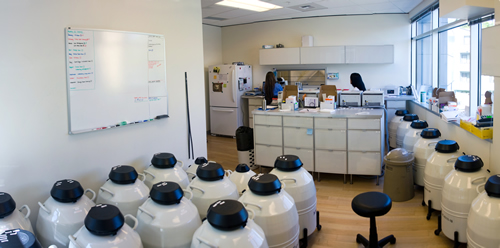A video explaining some of the benefits and the process of becoming a sperm donor.

Sperm banks provide a variety of information about their donors to help clients select a donor. This information may include:
To see an example list of donors, please visit the Seattle Sperm Bank Donor List.
It is important for sperm bank clients to select a donor who has a compatible blood type with the mother, to prevent pregnancy complications. However, clients may also use a variety of other information to select a donor, including physical appearance, education, personality traits, and genetics.

Most donor sperm is sent to a fertility clinic, where a medical practitioner will assist the recipient with artificial insemination. However, donor sperm may be also sent directly to the recipient, who may then perform her own artificial insemination.
The most common types of artificial insemination are:
Medically, a pregnancy achieved using donor sperm and artificial insemination is no different from a pregnancy achieved using partner sperm and sexual intercourse.

Before donating, sperm donors begin by filling out an application that includes such information as their age, occupation, education, and ancestry. After their initial application, donors provide a sperm sample for initial analysis, and then they provide a blood sample and an extensive medical history. Finally, sperm donors take blood tests throughout the time of their donations for:
Sperm is frozen and stored for a minimum of 6 months before being released for use to ensure that the donor is healthy and disease-free. For a sperm bank with extensive testing, see the Seattle Sperm Bank: www.seattlespermbank.com.

Every year, thousands of women use sperm banks to become mothers despite circumstances that would otherwise make it difficult to become pregnant. Women who are single, have infertile male partners, or are in same-sex relationships particularly benefit from sperm banks. In addition, couples who are at high risk of inherited diseases, such as Tay-Sachs disease and cystic fibrosis, may also use donor sperm to produce a child.
It is important to understand that while sperm banks help couples who have fertility issues, they do not provide a physical cure for infertility. Women who become pregnant through the most common types of artificial insemination (intra-cervical insemination and intra-uterine insemination) must themselves be fertile. Children conceived through artificial insemination will be genetically related to the sperm donor, not the mother’s partner (unless they are the same person).

After a sperm sample is collected, it is tested for:
After testing the sperm may be washed, which concentrates the sperm and removes dead cells. Finally, it is then stored in small vials or straws and cryogenically preserved in liquid nitrogen tanks.

A sperm bank collects, stores, and tests human sperm from a variety of donors. The primary purpose of the sperm bank is to help women become pregnant through third-party reproduction, primarily artificial insemination. Some sperm banks also provide material for research purposes.
In the United States, sperm banks are highly regulated by the FDA and several state agencies, including the New York State Department of Health and the California State Department of Health. These regulations protect the unborn children by ensuring the donors are healthy and free of diseases that are transmissible through semen. An example of a sperm bank that is licensed by the FDA, the State of New York, and the State of California is Seattle Sperm Bank.
